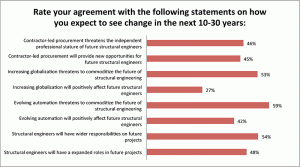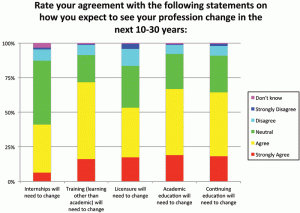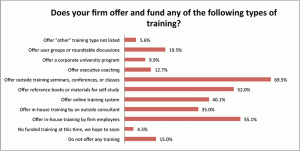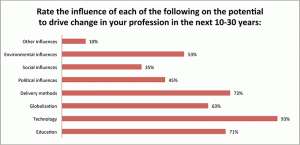How will the practice of structural engineering and the industry as a whole evolve from its current state? What are the opportunities and challenges in our continually changing industry? To answer these questions and more, the ASCE Structural Engineering Institute (SEI) surveyed structural engineering leaders nationwide in January 2013. Questions ranged from basic demographics to operational issues, licensure, and the ranked importance of external influences on the professional in the coming decade. The Business Practices Committee developed many of the questions with the intent of taking the engineering community’s pulse about its concerns and interests; feedback from the survey will have an impact on the committee’s future work.
This article looks at survey responses, indicative of what senior structural engineers anticipate may change in our industry. Based on responses from senior leaders, there is a lot of uncertainty about globalization and the resulting commoditization of the profession. Despite concern about the future, many respondents recognize the opportunity to improve the relevance and respect of the profession by harnessing evolving technology and improving education and licensure. In the era of BIM and with code updates on a 3-5 year cycle, there is a need to have personnel on staff who are technologically capable. But, the more important need is for management to be able to synthesize new ideas, integrate them into the business quickly and effectively, maintain consistency with the engineer’s standard of care, and ultimately, be profitable.
Survey Demographics
Invitations for the online survey were emailed to 10,065 members of SEI and NCSEA and 352 completed responses were received, resulting in a 3.5% response rate. 72% of respondents represent senior leadership positions such as owners, presidents, and lead engineers of their respective firms. The remaining respondents include project managers and senior/project engineers.
78% of respondents have more than 5 years tenure at their current employer, and 25% have more than 25 years tenure. Approximately half identify “structural engineering consulting firm” as the primary practice type. The remaining respondents include those within academia, large A/E or E/A firms, government, and specialty areas such as forensic engineering. Most respondents (86%) work in the private sector. 50% of respondents work at firms with 25 or fewer total staff, and 17% are employed at firms with more than 500. Most respondents serve one or more market sectors, with commercial the predominant sector (84%.) The other most heavily represented sectors include K-12/higher education (65%), industrial/energy/defense buildings (62%), healthcare (58%), and multifamily residential (58%). The top three client bases are building owners, contractors, and architects at 71%, 67%, and 62%, respectively.
Survey Results
Results indicate four primary areas of potential changes and opportunities: globalization, education requirements (both academic and continuing education), licensure, and technology.
Engineering as a Commodity
How do survey respondents expect the engineering profession to change in the next 10-30 years? Figure 1a illustrates that more than 50% are concerned that structural engineering services will become a commodity. Many see a direct correlation between globalization and commoditization of the industry due to both increased global competition and the automation of analysis and drafting. One responder noted, “Globalization is increasing the availability of engineers for working on projects, putting a lot of downward pressure on U.S. (engineer) labor rates. Conversely, inconsistent registration and continuing education requirements are making it very expensive for the individual to maintain licenses. Thus the individual engineer sees salaries declining, but the cost to be an engineer increasing.”
Further exploring this question, how do senior leaders anticipate their individual firms will adapt in response to the larger anticipated industry changes? The question posed in Figure 1b dealt with training and licensure issues. More than half of respondents acknowledge licensure needs to evolve; however, a larger percentage indicated an emphasis on training, academic, and continuing education. Nearly three out of four (72%) thought the way we train engineers in the workplace would have to change.
Educating the Engineer
To attract and retain future structural engineers, respondents expect to see significant future changes to education. Most agree we will see changes in the following areas:
- on-the- job training (72%),
- academic education (68%),
- continuing education (64%), and
- licensure requirements (54%).
Respondents that typically hire engineers with a Masters degree are 27%, while the remainder hire candidates with either a Bachelors or a Masters degree. At the same time, only 23% of responders indicate “students are generally well prepared when they start their careers at your firm.” 45% indicate “there is considerable variation from one school to the next, so we are careful from which school we select engineers.”
Notable disagreement occurs among responder comments regarding academic education. Some comment that engineering education is too broad and students do not graduate with sufficient technical skills. Others note graduates have insufficient written and communication skills. Comments staunchly in favor of graduate education requirements contrast with those who believe additional education requirements will cause “unnecessary burdens.” Gaps between theory knowledge and practical knowledge in some college programs are also noted. Interestingly, 92% of respondents indicate they only have specific knowledge of the academic program and university from which they graduated. This suggests that varied opinions on education may be based more upon specific personal experiences, versus a broad knowledge of recent graduates or the education curriculum in general.
Continuing education and training opportunities after graduation also vary widely. Figure 2 illustrates that 69.5% of firms offer out-of-firm funded training such as seminars, conferences, or classes. 20% offer no funded training opportunities. Interestingly, several responders in leadership positions comment that they will need to provide better training and continuing education opportunities in the future to retain employees. “As new generations of professionals come into the organization, they will want formal programs that will move the companies in that direction in order to attract and retain talent,” according to one respondent.
The quality and relevancy of continuing education requirements is also of general concern. One responder notes, “The continuing education requirements have created an industry unto itself, which charges confiscatory rates for classes that have little to do with what most of us…use day-to-day.” Multiple responders indicate the frequency of code revisions causes a challenge with regard to continuing education: “The codes are continually changing…for the better, I’m not sure, to be exhaustively confusing…that’s a definite yes.”
Stamp of Approval
Many of those surveyed saw licensure concerns, continuing education, and code revisions to be linked. “Frequent code changes make keeping up with the definition of the ‘standard of care’ more challenging,” states one responder. “Creating a national license will help reduce the efforts to get renewals completed so more time is (available) for other things like education.”
Who pays for licensure? 62% of respondents’ firms pay for licensure exam fees. 37% also provide paid leave for exams, and 28% provide paid exam prep classes. 86% of respondents indicate their employer pays for professional registration fees in at least one state. Responders across the board have concerns about inconsistencies between states regarding licensure. As one respondent succinctly notes, “Structural engineers need to do a better job of self-regulating licensure.”
The Human Side of Technology
Technology is clearly rated by respondents to be the strongest potential influence and driver of change as shown in Figure 3. New technologies create both challenges and opportunities. Several responders note concerns related to the automation of analysis resulting in “designs without a full understanding of overall (structural) performance.” Not surprisingly, there were also many comments regarding BIM, both positive and negative.
Respondents recognize both significant opportunities and challenges in the area of technology. One respondent notes “Structural engineers will need to find new ways to develop their skills and roles in projects. Automation of analysis and design will replace the work of the early years of SEs’ training. This will eliminate some of the important present training activities, and require engineers to enter the work force at a higher level…Our role could evolve into a higher level of contribution to project conceptualization and success.”
Interpretation of Survey Findings
What do these findings tell us? Our interpretation is focused on how the structural engineer is positioned for business.
The following two key questions emerge from the results above that affect how we run our businesses:
- Does globalization of the engineering profession mean commoditization of structural engineering services?
- How do external pressures and constantly changing factors affect our ability to provide a high quality product that will ensure the success of our individual firms?
Guarding the Industry
Question 1 clearly raises concerns. Fear of commoditization would devalue the profession as engineering services become cheaper to obtain in a global market. However, the potential problem is more or less self-correcting; firms charging low fees in order to compete may find their work quality suffers. Commoditization suggests the overall quality of the product would be less in the long term. If a firm continually rises to the challenges of a changing environment by attracting top talent and performing high quality work, it will be recognized as a resilient and reliable business partner that contributes value to projects commensurate with their fee structure. These firms will continue to be successful.
Turning Change into Opportunity
There is clearly a positive side to change and this is reinforced by the significant optimism in how structural engineers see the future (Figure 1a). However, there is no question that the majority of engineers think that changes such as globalization, automation, and new procurement methods are more likely to negatively impact the profession. Engineers are largely analytical and driven by facts, so it is not surprising they are willing to accept negative outcomes from forces beyond their control. However, with the exception of the response to changes due to globalization, the number of respondents with a positive outlook was 40% or more of the total.
One response from the survey question “What opportunities are created or challenges are caused by changes in your profession?” speaks to this point while clearly demonstrating the tendency of structural engineers to remain grounded in reality, as follows:
“Inherently, Structural Engineers are excellent problem solvers. We are capable of processing large amounts of data from multiple sources, and developing safe and economical solutions to very complex problems. This makes us capable of becoming leaders in the business of providing extremely valuable services to the societies in which we live. Unfortunately, we have allowed lawyers, insurance companies, politicians, global corporations, banks, and investment firms to devalue our professional worth. Hence, I strongly believe that structural engineers have a duty to band together as a collective entity, use our superior problem-solving abilities, and wisely use the influence we have left to improve the societies we serve…”
Balancing Technology and Experience
From Question 2, we can draw some conclusions about what structural engineers identify as the most important ways to influence the quality of their work. Figure 3 shows that among senior leaders, the three strongest factors driving change are delivery methods, technology, and education. Of these, technology seems to be a universally accepted factor, as 93% of respondents acknowledge that it has an impact.
Presuming that technological improvements continue to make analysis and design a more automated task, respondents recognize the need to manage the integration of technology into the design process. One comment succinctly states, “the industry’s dependence on technology is increasing so fast that graduates do not have a good grasp on the basics of design.”
The increasing adoption of technology has direct implication on training; as junior engineers rely more on technology, it will require the engineer of record to be more involved in the training process. Junior engineers likely know the software well, but lack the experience to be able to recognize questionable outcomes. The engineer of record fulfills the role of a “detached overseer” who is relying on his experience to anticipate expected outcomes.
The Ongoing Education Process
Figure 1b indicates that senior leaders see a need to change the way junior engineers are trained to do their jobs. This, combined with over half of respondents expecting changes in licensure, indicates that the way we practice project oversight may need to adapt. With concerns about the fast-paced code cycle, experienced engineers are also under the gun to keep their knowledge up-to-date while managing production staff.
Engineers don’t believe in a quick fix either. The discussion about the continuing education process and the effectiveness of classes provided by CEU consulting firms indicates that engineers would rather be responsible for training their own people. The training process is an ongoing one for EITs who develop the proficiency needed to pass licensure exams. If engineers are only trained to “pass the test”, they will fail to develop the engineering judgment needed for the unique requirements of each project. This fact connects the concerns seen in survey responses about the need for changes in licensure and training/education, and the threat of commoditization of the profession.
SEI Visioning and Strategic Initiatives
The survey results and interpretations present interesting insight into current and anticipated concerns for practicing engineers. From a larger perspective, the results also validate the SEI Strategic initiatives (see below). As practicing engineers, we continually see change, but in the short term can fail to acknowledge the need to adapt. To find out more about the Vision for the Future of Structural Engineering: A Case for Change, you can read the 2013 report from the SEI Board of Governors (available at www.asce.org/sei/about-sei/ under Strategic Visioning), which contains additional information about the survey and recommendations for further action.▪
In 2011, the SEI Board of Governors (BOG) met and identified four strategic initiatives for the board as they move forward. They are:
- Expectations and Role of the Future Structural Engineer
- Structural Engineering Licensing
- Continuing Education
- International Links and Globalization
As shown in the survey data for the type of changes expected in the next 10-30 years and the drivers and influences in the SE industry that were collected for this report, the respondents’ views are closely aligned with those of the BOG’s. It is apparent by the BOG’s actions and the survey results that we, as structural engineers, will need to address these issues.
The SEI Business Practices Committee:
Chair, Joseph Di Pompeo, P.E., SECB, M. ASCE – President, Structural Workshop, LLC
Amol (Andy) Fulambarkar, P.E., M. ASCE – Principal, Soil & Structure Consulting, Inc.
Paul Hause, P.E., M. ASCE – President, Structural Consultants, Inc.
Patrick McCormick, P.E., M. ASCE, F.SEI – President, Brander Construction Technology
Scott Rosemann, P.E., M. ASCE, LEED AP – C.O.O., Rosemann & Associates, P.C.




